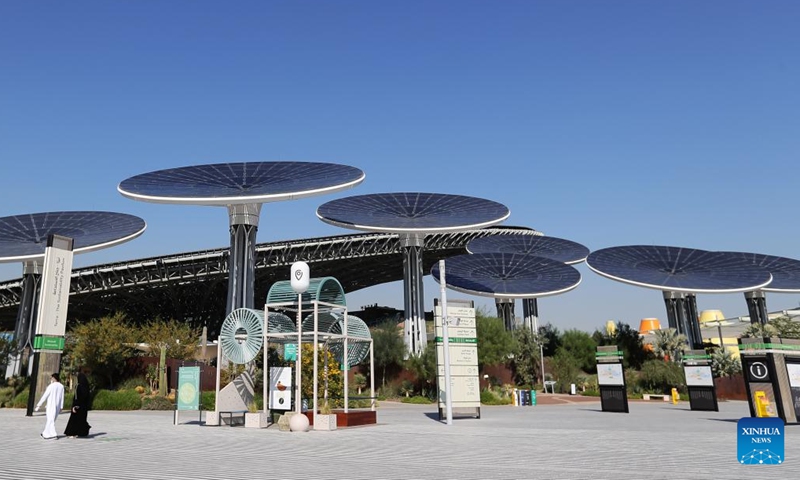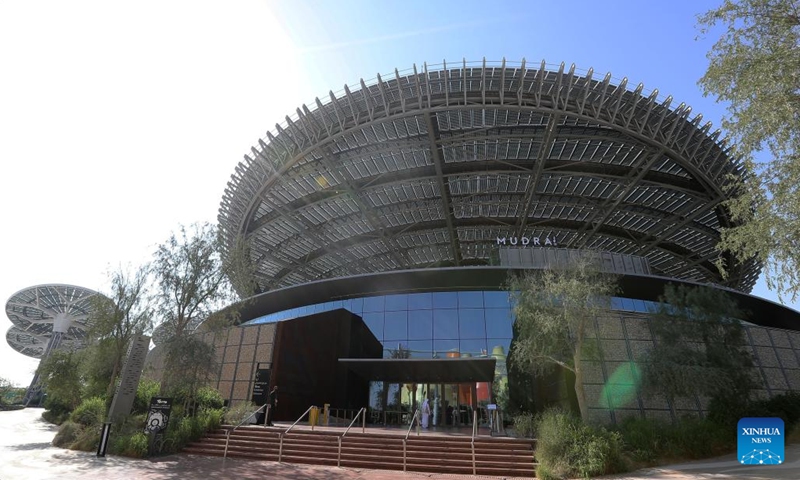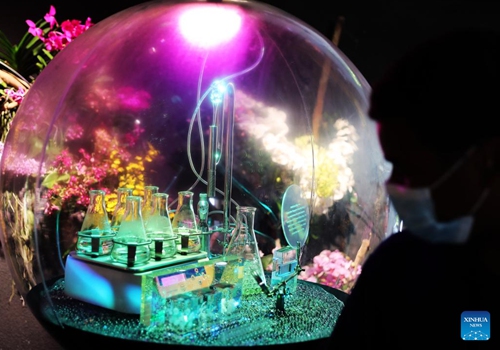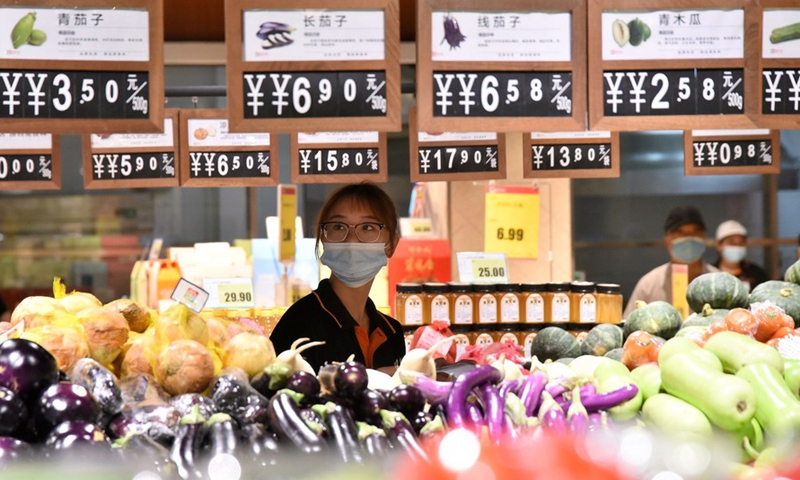
Photo taken on Jan. 11, 2022 shows the "energy trees" at the Expo 2020 Dubai in Dubai, the United Arab Emirates.(Photo: Xinhua)

Photo taken on Jan. 11, 2022 shows the Sustainable Pavilion of the Expo 2020 Dubai in Dubai, the United Arab Emirates.(Photo: Xinhua)

A tourist visits the Singapore Pavilion of the Expo 2020 Dubai in Dubai, the United Arab Emirates, on Jan. 11, 2022.(Photo: Xinhua)

A customer buys vegetables at a supermarket in Handan, North China's Hebei province.Photo:Xinhua
After passing through a jaw-dropping gigantic portal made of carbon fiber and entering the Sustainability Gate of the Expo 2020 Dubai, the first thing you will see is a forest of "energy trees."
As many as 18 "energy trees" rotate their large crowns to face the sunlight just like sunflowers. Behind the energy trees, a giant canopy arises, commanding a space of over 6,000 square meters.
The pavilion, also known as Terra, is one of three major theme pavilions that respectively embody the three sub-themes of the Expo, which are "Opportunity, Mobility, and Sustainability."
To drive the point home, the architects of Terra spared no effort to make the pavilion aspirational advocacy of the sustainable way of living.
Inspired by the drought-tolerant Ghaf tree, the national tree of the United Arab Emirates (UAE), the pavilion has applied the latest technologies to capture energy from sunlight and freshwater from the air.
On the "energy trees" and the 130-meter-wide canopy, there are 4,912 solar panels, which help generate 4 GWh of electricity every year, enough to charge more than 900,000 smartphones.
The China Pavilion, one of the largest national pavilions and a must-see at the Expo, is also a shining champion of sustainability.
Similar to Terra, the "Light of China" has adopted a series of environmental-friendly technologies to reduce carbon foot prints.
It also showcases many Chinese innovations in this area and the resolution of China to contribute to building a sustainable future for the world.
The Netherlands Pavilion has also created an enclosed water, energy, and food system that achieves a high level of self-sufficiency.
One of the most innovative features of the pavilion is the translucent and colorful solar panels covering the roof, which allow in sunlight at the wavelengths that plants in the pavilion's need for photosynthesis.
The pavilion has also put up an 18-meter-high vertical farm at the center, on which more than 9,000 edible plants, such as asparagus, basil, and mint, are carefully cultivated and then harvested for the restaurant.
A staff member at the pavilion said that the water collecting devices here can extract up to 1,300 liters of water from the air, which is used to irrigate the plants on the "food cone" and is purified into drinking water for guests.
Embracing a leave-no-trace philosophy, the architecture of the pavilion is not intended to be a visual spectacle, but to support its function as a "harvesting machine" and to reinforce the sustainability message.
The pavilion was built from steel that will be reused once the expo is over. The walls are made from steel sheet piling and the roof from steel tubes, while concrete was avoided in the pavilion foundations.
"Being a temporary pavilion, one of the most important things to us is that everything would be taken away again, and return the place to what it used to be," the staff member said.
The Germany Pavilion also provides visitors with a great experience in sustainability innovations.
Officially dubbed as "Campus Germany," the pavilion has placed "edutainment" at the central stage. It mimics the experience of college, where "students," whether they are children or adults, can learn about German innovations and solutions in the field of sustainability.
After the visitors get "enrolled," they will first come across a huge ball pit that is filled with 100,000 balls. Each ball contains a story, a statistic, or an idea about environmental protection. Visitors can pick a ball and place it on one of the scanners to see a short presentation.
The tour of Campus Germany ends with an inspiring "Graduation" ceremony. After learning many things about sustainability, the visitors sit on the swing seats and are given the task of making the seats swing together, marveling at the incredible results they can achieve together.
The message is clear: if all human kinds work together, we can solve the pressing problem of climate change and achieve sustainability.
"The experience is amazing. Usually, when they talk about climate change or environmental problems, the tone is very serious. But here at the German Pavilion, I find it can also be promising and hopeful," said an American visitor named Joshua Armstrong.
Walking inside the Singapore Pavilion is just like walking inside Singapore, the garden city. Lush plants, trees, and shrubs have become integral parts of the building.
When visitors walk upwards along the spiraling galleria, the greenness continues along the way. Then you can find more gardens and trees.
The self-sustaining pavilion is powered by solar panels on the glass roof. Saline water is drawn from underground and desalinated to irrigate all the plants. The pavilion uses mist fans to permeate the atmosphere with small water drops, which can significantly cool down the venue by six to ten degrees Celsius. So there is no need for air-conditioning, even though it is located in a scorching desert in Dubai.
Priding it as an "oasis in the desert," a staff member at the Singapore Pavilion said that "it showcases the coexistence of architecture and nature. It demonstrates that buildings can be designed as responsible and sustainable for the environment, achieving net-zero energy and water use in the desert."
